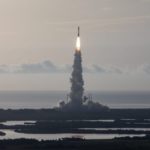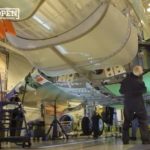SpaceX’s Crew Dragon splashed down safely in the Gulf of Mexico marking the end of a successful test flight.
The spacecraft carrying NASA astronauts Robert Behnken and Douglas Hurley was recovered by SpaceX and brought aboard the recovery ship ‘Go Navigator.’ SpaceX Crew Dragon is the first commercially built and operated American crew spacecraft. After the successful recovery, the astronauts flew back to Houston.
NASA Administrator Jim Bridenstine said: “Welcome home, Bob and Doug! Congratulations to the NASA and SpaceX teams for the incredible work to make this test flight possible. It’s a testament to what we can accomplish when we work together to do something once thought impossible. Partners are key to how we go farther than ever before and take the next steps on daring missions to the Moon and Mars.”
First US splashdown since 1975
Behnken and Hurley’s return was the first splashdown for American astronauts since Thomas Stafford, Vance Brand, and Donald “Deke” Slayton landed in the Pacific Ocean off the coast of Hawaii on July 24, 1975, at the end of the Apollo-Soyuz Test Project. NASA’s SpaceX Demo-2 test flight launched May 30 from the Kennedy Space Center in Florida. Nearly 19 hours later, Crew Dragon docked to the forward port of the International Space Station’s Harmony module.
SpaceX President and Chief Operating Officer Gwynne Shotwell said: “On behalf of all SpaceX employees, thank you to NASA for the opportunity to return human spaceflight to the United States by flying NASA astronauts Bob Behnken and Doug Hurley. Congratulations to the entire SpaceX and NASA team on such an extraordinary mission. We could not be more proud to see Bob and Doug safely back home—we all appreciate their dedication to this mission and helping us start the journey towards carrying people regularly to low Earth orbit and on to the Moon and Mars. And I really hope they enjoyed the ride!”
Crew spent 64 days in orbit
Behnken and Hurley participated in a number of scientific experiments, spacewalks and public engagement events during their 62 days aboard station. Overall, the astronaut duo spent 64 days in orbit, completed 1,024 orbits around Earth and traveled 27,147,284 statute miles.
The astronauts contributed more than 100 hours of time to supporting the orbiting laboratory’s investigations including the Droplet Formation Study inside of the Microgravity Science Glovebox (MSG) and an Electrolysis Measurement (EM) experiment, which looks at bubbles created using electrolysis which has implications for numerous electrochemical reactions and devices.
Recording how the Earth is changing
Both crew members also contributed images to the Crew Earth Observations (CEO) study which helps record how our planet is changing over time, from human-caused changes – such as urban growth and reservoir construction – to natural dynamic events, including hurricanes, floods, and volcanic eruptions.
Behnken conducted four spacewalks while on board the space station with Expedition 63 Commander and NASA colleague Chris Cassidy carrying out upgrading and installation work to the ISS.
The Demo-2 test flight is part of NASA’s Commercial Crew Program, which has worked with the US aerospace industry to launch astronauts on American rockets and spacecraft from American soil to the space station for the first time since 2011. This is SpaceX’s final test flight and is providing data on the performance of the Falcon 9 rocket, Crew Dragon spacecraft and ground systems, as well as in-orbit, docking, splashdown, and recovery operations.
SpaceX readying hardware for first rotation mission
Crew Dragon Endeavour will return back to SpaceX’s Dragon Lair in Florida for inspection and processing. Teams will examine the spacecraft’s data and performance from throughout the test flight. The completion of Demo-2 and the review of the mission and spacecraft pave the way for NASA to certify SpaceX’s crew transportation system for regular flights carrying astronauts to and from the space station. SpaceX is readying the hardware for the first rotational mission, called Crew-1, later this year. This mission would occur after NASA certification, which is expected to take about six weeks.
The goal of NASA’s Commercial Crew Program is safe, reliable and cost-effective transportation to and from the International Space Station. This could allow for additional research time and increase the opportunity for discovery aboard humanity’s testbed for exploration, including helping us prepare for human exploration of the Moon and Mars.
Subscribe to the FINN weekly newsletter

